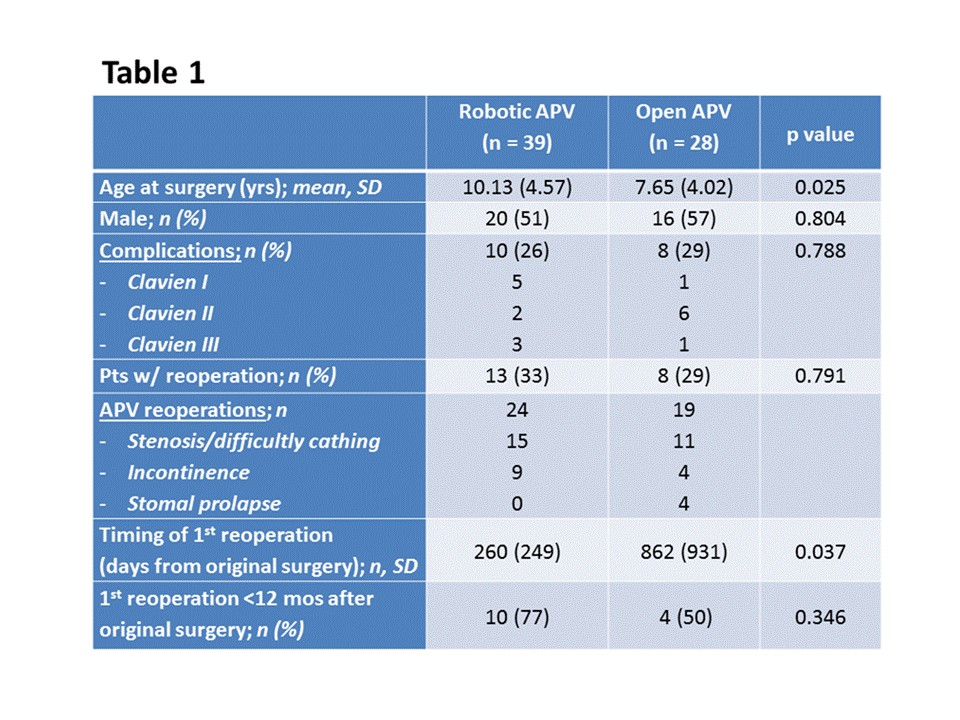-->
|
Back to 2014 Fall Congress Meeting Abstracts
A Comparison of Complications of Robotic Assisted Laparoscopic versus Open Appendicovesicstomy in Children
Gwen M. Grimsby, MD1, Linda A. Baker, MD1, Micah A. Jacobs, MD, MPH1, Patricio C. Gargollo, MD2.
1UT Southwestern Medical Center/Children's Medical Center, Dallas, TX, USA, 24. Texas Children’s Hospital / Baylor College of Medicine, Houston, TX, Houston, TX, USA.
Introduction: There is a paucity of literature regarding the outcomes of robotic appendicovesicostomies (APVs). In addition, existing reports only describe small case series with no comparisons of outcomes to a cohort of patients after an open approach. The goal of this study was to compare the number of complications and surgical revisions required between open and robotic APVs in children.
Materials and Methods: After IRB approval, a retrospective chart review was performed of all patients who underwent formation of a catheterizable channel at a single institution from 7/2002 to 9/2013 by 1 of 3 surgeons who routinely perform both approaches. Patients who underwent a Monti were excluded. The number of acute complications, classified by the Clavien-Dindo grading system as well as number of surgical revisions were recorded and compared between groups with t tests for continuous variables and Fisher’s exact test for categorical variables.
Results: After exclusion of 13 Montis, 39 robotic and 28 open APVs remained for analysis. As can be seen in Table 1, there was no difference in gender between groups, however, patients who underwent a robotic approach were significantly older. At time of last follow up, there was no difference in number of complications or re-operations between groups, Table 1. Acute complications in the robotic group included 3 bowel obstructions, 3 hospital readmissions, 2 wound infections, and 2 febrile UTIs. Acute complications in the open cohort included 2 febrile UTIs, 1 urine leak, 1 bowel obstruction, 1 hospital readmission for vomiting, 1 peritonitis, 1 Clostridium difficile infection, and 1 foot drop. With regards to re-operations, it should be noted that the length of follow up is significantly longer in the open (1257 days) versus the robotic (601) cohort. Time to first reoperation was also shorter in the robotic group. However, there was no significant difference in the number of patients who had a re-operation within the first 12 months between the open and robotic groups, Table 1.
Conclusions: This is the largest series of robotic APV outcomes and complications. A comparison with open APVs found that there was no difference in the number of acute complications between groups. There was also no difference in the number of re-operations between groups; however the open cohort had an overall longer follow up which suggests that the robotic patients may experience earlier chronic complications requiring re-operation. This
preliminary data suggests that the open and robotic approaches might have similar acute and chronic complication profiles but longer follow up of the robotic cohorts is warranted.

Back to 2014 Fall Congress Meeting Abstracts
|


